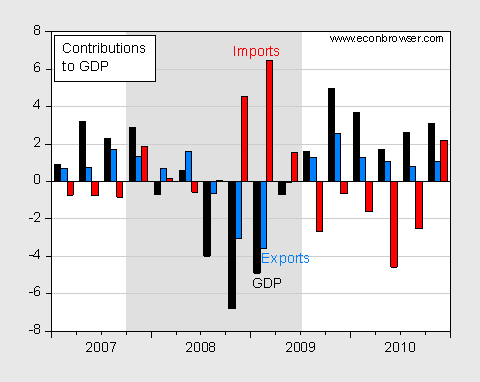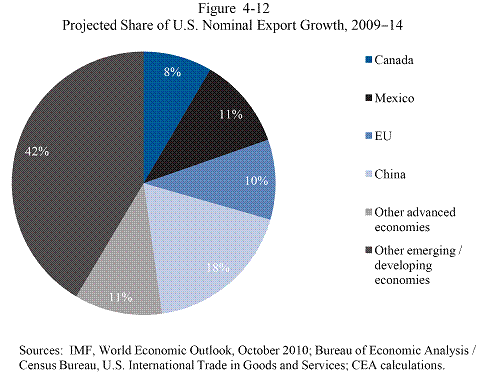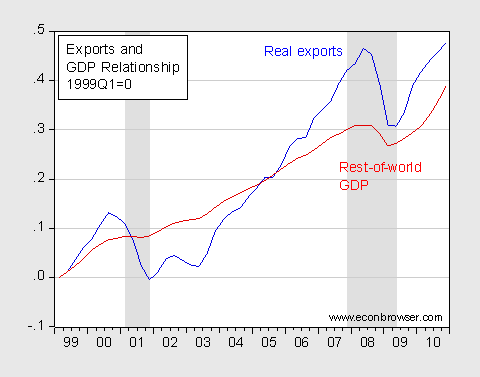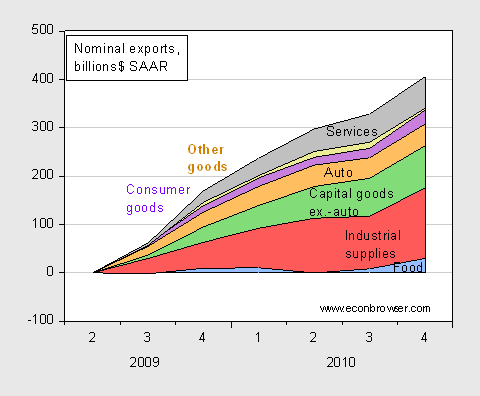Exports in Context
Anybody who follows forecasts of GDP growth for 2011Q1 will notice that over time, estimates have been revised down (this is true for Macroeconomic Advisers, for instance). The dimmed prospects for GDP growth throws in high relief the importance of net exports. From the WSJ, “Foreign Shocks Temper America’s Export-Led Rebound”:
To an extent unique in post-World War II history, the U.S. economy’s climb out of recession has been led by selling crops, natural resources and manufactured goods to the rest of the world.
…
Now that important engine for U.S. growth—the rest of the world—is damping the improving outlook. The world’s No. 3 economy, Japan, is reeling from an earthquake and nuclear crisis. Unrest in the Middle East has sent oil prices—and global anxiety—soaring. Fast-growing China, anxious about inflation, and other emerging markets are trying to tap the brakes. And fiscal strain looms over Europe.
The contribution of export spending to GPD growth in an accounting sense (q/q, SAAR) is illustrated in Figure 1.

Figure 1: Real GDP growth, q/q SAAR (black bars) and contributions to GDP growth from exports (blue bars) and from imports (red bars). NBER defined recession dates shaded gray. Source: BEA, 2010Q4 third release, and NBER.
The importance of exports was also highlighted in Chapter 4 of the recently released Economic Report of the President. The report notes (p. 102):
U.S. export growth also benefits from changes in relative prices caused
by faster inflation in growing emerging markets because faster inflation
abroad means U.S. goods are cheaper on world markets relative to goods
from these countries. These price and growth relationships suggest that if
the United States is to double exports, an overwhelming portion of that
new export growth will come from faster-growing emerging and developing
economies. Figure 4-12 shows the share of projected growth of U.S. nominal
exports by region using IMF forecasts for GDP and price growth in different
regions.
Here is Figure 4-12.

Figure 4-12 from Economic Report of the President, 2011, Ch. 4.
These projections depend on projections of growth abroad, and the elasticity of [nominal] export demand with respect to income.
How Big Are Export Elasticities Now?
These projections are based upon elasticites of [nominal] exports with respect to growth of around 2, and one of the cited sources is Chinn (2005). Those estimates were based upon time series data up to 2001Q2, [and pertain to real exports]. My subsequent work (see [1] and [2]) has taken into account potentially important supply side factors (that is, the quantity of exports depends on foreign demand as well as domestic supply). I obtain some slightly lower estimates of income elasticities imposing equality on supply and demand factors, but that result is suspect given the co-trending nature of rest-of-world growth and proxy measures for US capacity. Moreover, the fact that the [nominal export] elasticity estimates cited in the ERP are around two for cross section-based estimates does suggest that the elasticities are fairly high (the ERP notes that dropping Singapore pushes up the income elasticity to three).
In any case, I wanted to re-investigate this question, using the most recent data, up through 2010Q4. Figure 2 shows log real exports and log real rest-of-world GDP, rebased to 0 in 1999Q1.

Figure 2: Log real exports, in Ch.2005$ SAAR (blue line) and log real rest-of-world GDP, measured as a Divisia index (red line). Source: BEA, 2010Q4 third release; Federal Reserve up to 2009, updated using data from Economist thereafter; and author’s calculations. Note: Extrapolation incorporates GDP for 80% of US exports.
Notice that real exports are 18.4% above their trough in 2009Q2 (and 1.1% above their pre-recession peak in 2008Q2), while rest-of-world GDP was up by 15.2% relative to that same period. Nominal exports are 26.7% above trough levels; this figure is of interest given the President’s goal of doubling exports, as discussed in this post.
In order to more formally assess the export-income relationship, I disaggregated into goods and services. For each, I estimated the following error correction model with up to two lags. (The approach follows that outlined in this post.)
Δ exp t = β 0 + φ exp t-1 + β 1 y t-1 + β 2 r t-1 + γ 0 Δ exp t-1 + γ 1 Δ exp t-2 + γ 2 Δ y *t-1 + γ 3 Δ y *t-2 + γ 4 Δ r t-1 + γ 5 Δ r t-2 + u t
For goods exports, only one lag of each variable was necessary.
I find that the long run elasticity of goods exports over the 1975Q1-2010Q4 period is 1.84 (while the long run price elasticity is 0.92). Both coefficients are statistically significantly different from zero at conventional levels, using robust standard errors. The error correction specification seems adequate, with the adjusted-R2 = 0.34, the standard error of regression at 0.024, and the usual tests for serial correlation in residuals failing to reject at conventional levels (Q(4), Q(8), LM test with 2 lags).
The long run elasticity of services exports over the 1975Q1-2010Q4 period is 1.59 (while the long run price elasticity is 0.49). In this case, only the long run income coefficient is statistically significantly different from zero at conventional levels, using robust standard errors. The error correction specification seems a bit less successful, with the adjusted-R2 = 0.13, the standard error of regression at 0.028, and the usual tests for serial correlation in residuals failing to reject at conventional levels (Q(4), Q(8), LM test with 2 lags).
Dealing with the supply capacity is difficult. One could try to measure the size of the goods exports capacity using the capital stock. I’ve tried to capture the trend using manufacturing output. This variable is of course endogenous, but if one is trying to get the long run effect, might not be a problem. One way to see if statistically manufacturing production is endogenous with respect to the cointegrating vector is to see if log manufacturing production is weakly exogenous. I estimate a VEC(3) (consistent with a VAR specification with 4 lags), and check the statistical significance of the reversion coefficient on manufacturing production. A likelihood ratio test restricting the reversion coefficient to be zero fails to reject.
Re-estimating the goods export equation yields a slightly lower income elasticity, of 1.3. On the other hand, while the supply elasticity is positive (as anticipated) at 0.62, the long run coefficient is not statistically significant. (The adjusted R2 rises only slightly to 0.36.).
Do these results imply an elasticity of [nominal exports] of 2 is too high? Using this error correction specification’s point estimates, the top of the one standard error band places the long run coefficient at 2.3 [for real exports], and the bottom at 0.7; in other words, a demand elasticity of 2 is still quite plausible given the imprecision of the estimates. Cross-checking, I used dynamic OLS (allowing in a linear time trend, two leads and lags). This leads to a point estimate of 1.74, with (long run) standard error of 0.80, once again easily encompassing the 2.0 estimate [and since prices typically rise, easily validates the assumption of a nominal export elasticity of 2].
Limitations of the Preceding Analysis
Even though I’ve broken down exports into goods and services, clearly one could disaggregate further. In this paper, I do; the conclusions are not particularly clear, given the sensitivity of results to trends. The income and price elasticities vary over categories (and income elasticities can easily exceed 2, depending on the assumptions regarding time trends).
In addition, the composition of exports is changing over time, which implies changes in the sensitivity of trade flows to both income and exchange rates. Figure 3 illustrates the changes in the (nominal) flows of exports by category, since 2009Q2.

Figure 3: Change in exports, in billions of $, SAAR, relative to 2009Q2. Source: BEA, 2010Q4 third release.
It’s hard to say what this changing composition of exports implies for the aggregate income elasticity. To the extent that services are a rising share of total exports, the income elasticity might decline in aggregate (goods and services). On the other hand, the composition of services is shifting toward other private services (and away from travel and passenger fares). If service sectors abroad are liberalized, one could see measured income elasticities rise.
Global Rebalancing and Partial Equilibrium Analysis
There is a tendency to dismiss the partial equilibrium/static approach that is central when discussing the impacts of policies on trade flows. I agree that these types of elasticities are only part of the story, when one wants to discuss the prospects for global rebalancing. Aggregate saving (both public and private) and investment also matter; however, it would be wrong to take those as variables as strictly exogenous. Focus on those aggregates can also lead to analytical mis-steps. As Manoj Pradhan (Morgan Stanley) and Alan Taylor (Morgan Stanley and UC Davis) noted in an provocative blogpost yesterday:
we see lasting consequences beyond those unfolding in the immediate aftermath of the financial crisis:
- A huge rise in demand for capital in EMs with a more moderate increase in DMs. Talk of a savings glut or an investment drought may recede. The global real interest rate is likely to rise.
- Less saving flows out of EM economies. Growth prospects are the main driver but risk premia for newly resilient EMs may fall. If investment demand is muted in DMs, and saving flat, the shift is weaker in DMs. Global imbalances moderate, reinforcing the trends after the crisis.
- These current account shifts cannot be an “immaculate transfer” without real exchange rate adjustment. Recent real appreciation of EMs took the form of relative inflation and managed currencies (the latter creating political distractions). But EMs are likely to absorb further adjustment through nominal appreciation, given a triple whammy of cyclical reflation, growth differentials pushing nontradable inflation and oil/commodity price shocks. [Emphasis added — mdc]
Tracing out how income and relative price changes translates concretely into changes in flows requires some insight on these elasticities, even when acknowledging the partial nature of the analysis.
In addition, to the extent that there are nominal rigidities, monetary shocks could induce short run movements in trade flows that are partially unrelated to changes in savings and investment.
Note: Minor edits in [brackets], 4/1/2011.
Thanks. Lots to digest.
It’s interesting to think about this in light of the GOP’s strange pushing of the idea that reducing public sector employment pressures private sector wages and we all then benefit. Trying to find some actual thing in that argument which isn’t nonsensical, I come up with exports, meaning in blunt terms a rather gross scale reduction in American living standards leading to a more competitive US internationally leading to more exports. The key in there is “reduction in American living standards” and of course it then assumes a) we can compete with the Chinese, Indians, etc. on cost and b) that the gain in exports is sufficient. I can’t in my head then get to the next step – which they may be thinking – that the export rise would be sufficient. (I call this the War on Prosperity.)
From the captioned studies,(USA) Services export are prices inelastic where manufacturing exports are .The results could not capture to which extent (volume) and when (timing), idle US production capacity was responsive to the incremental demand for export.”The long run elasticity of goods exports over the 1975Q1-2010Q4 period is 1.84 (while the long run price elasticity is 0.92)”
http://research.stlouisfed.org/economy/indicators/IndustrialProduction.pdf
Fed St Louis may assist or contribute to puzzling conclusion.Outlaying the main countries production with the same time base
month zero=june 2009),production indice at 100 at this same date.
The reading does not show a large production elasticity or products price elasticity for the USA, when compared to other nations. It takes 21 months production to bounce back around 110,less for most of the countries (save Australia and the UK).
A hasty conclusion, export price elasticity is not so obvious on this time frame or the production base at time zero June 2009, is not accurately reflecting a coincident international breakdown in the production (trade), as so often reported.
What’s with the one-sided concentration on exports? Imports seem to have been a bigger factor in most quarters. Net trade seems to have been a big positive influence in the latter part of 2008, owing to import shrinkage. In 2009 and 2010, foreign trade seems to have been mostly a net negative again, owing to a resurgence of imports, until the fourth quarter of 2010.
@don:
In theory, import changes shouldn’t have any effect at all on GDP growth. GDP is supposed to be an estimate of the domestic product. The consumer expenditure, investment, and government expenditure components of the GDP are all a sum of a domestic and an import component. For that reason, imports have to be subtracted in the GDP formula. If imports weren’t subtracted it would be an estimate of the domestic expenditure for domestic goods and services plus the domestic expenditures for imported goods and services plus exported goods and services, instead.
Assuming that the estimates of all the GDP components are sufficiently exact, any change in imports should show up again as a change in the import components of the consumer, investment, and government expenditure, the sum of which should be the same as the subtracted imports. Thus, these changes would cancel each other in the formula, whatever the magnitude of the change in imports was.
The other question is whether the statistical estimates are really as good, or whether there are distortions there so that the canceling doesn’t fully happen for the estimates done by the BEA in reality.
don:In addition to the linked posts, please refer to this post which deals with imports.
rootless:
Please note that in the simple Keynesian model, where demand is determining aggregate output, your first statement is incorrect. I believe that is the world we currently occupy. As Samuelson noted, in circumstances of demand-constrained output, all the jobs arguments for mercantilist trade policies turn out to be true in the first instance (before foreign retaliation). As for retaliation, as Krugman noted, China is holding an “unloaded squirtgun” to our heads.
@don:
My first statement was that GDP was the domestic product. Imports weren’t a part of the GDP. How can this be incorrect? This is true by definition. What is this supposed to have to do with some “simple Keynesian model”? And what the heck are you talking about in the remainder of your comment? What does this have to do with what I wrote? I wrote about the mathematics of the GDP formula.
However, I haven’t written about that there could be a shift in the expenditures from domestically produced goods and services to imported goods and services or the other way around. If, for instance, the shift is from domestic to import than GDP will go down and import will go up. Imports are still no part of GDP then.
Apart from ag exports, most US “exports” are to US supranational firms’ foreign subsidiaries and contract producers abroad, primarily China-Asia.
When Applied Materials ships capital goods to Malaysia, Taiwan, and China, and the goods go through the ports of Singapore and Hong Kong, for example, they are counted as “imports” to Asia; but the goods are going to, for example, Intel and other US firms’ subsidiaries and contract producers in Asia.
Once the capital goods are used to produce components and intermediate goods, the goods are then shipped often intra-Asia to other facilities, notably US firms’ facilities, where components and intermediate goods are used to fabricate higher value-add goods to “export” back to the US and increasingly intra-Asia or to the EU. These goods are counted as “Asian exports”, when they are more accurately US firms’ exports.
When Obummer and others advocate increasing US “exports”, whether they know it or not, they are effectively promoting US firms shipping more production, employment, value-add activities, and technology transfer to Asia in order to promote faster growth of revenues and profits in Asia, irrespective of whether it results in domestic US investment, production, and employment, which it likely will not, just as has not occurred for 20-25 years.
This neo-imperial “trade” regime is remarkably like what the British maintained from the 1870s to WW I, including “trade” with imperial holdings in Africa, South America, the Commonwealth countries, and the US. The British invested increasingly more money and capital outside of Britain in those 40 years than they did domestically. We know how that turned out for the UK.
But the hundreds of billions of dollars in investment in Asia by imperial US supranational firms is occurring with Peak Oil, military overstretch, and the price of oil at more than 5 times the level in inflation-adjusted terms during which the US and Japan rose to industrial powers.
Thus, despite US firms enabling China-Asia to reach GDP PPP and oil consumption parity with the US and Eurozone over the past 20-30 years, China-Asia is 40-80 years too late to the auto- and oil-based economic model of development and growth; but it does not appear that the Chinese know this, as they have the proverbial pedal to the metal going as fast as they can straight for a thermodynamic brick wall.
10-year avg. US real private GDP per capita is contracting, and global real private GDP per capita has plateaued. Peak Oil and population overshoot ensures that energy and food prices will remain high and squeeze firms’ margins and reduce investment and production hereafter, exacerbating food insecurity and social unrest around the world.
I don’t know what percentage of goods labeled ‘imports’ are actually products of foreign divisions of US based multinationals, but the basic concept seems true to me.
US corporations have been applying large capex for a decade or more now. It’s just that these investments are not in the US. And under current tax laws, it appears that not only is no new US labor is being employed, increased profits are not accruing to government revenue. A double whammy for the domestic economy.
And the concept of resource constraints appears to be unfolding as true. If that is the case, something very big has to give within the next 10 years.
rootless,
O.K. It may be a question of symantics. The equation “Y + C + I + G + (X – M)” can be viewed as an equilibrium condition in which output is determined by demand. In that case, then a net fall in (X – M) caused by, for example, currency interventions abroad, will reduce the U.S. level of aggregate demand for domestioc product and hence Y (GDP).
I disputed your statement “In theory, import changes shouldn’t have any effect at all on GDP growth.” The statement is incorrect under conditions of demand-constrained output, whether import changes come in response to changes in U.S. demand (in which case they are likely to ameliorate the net effect on domestic GDP), or the result of foreign commercial policy (which is why I made reference to Samuelson’s statement.)